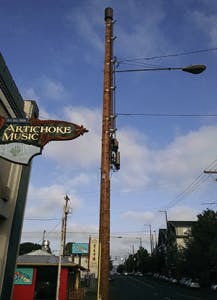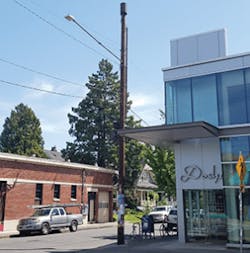Are You In The Right?
A Guide to Deploying Small Cells in the Public Right of Way:
Some things seem difficult, but are actually much easier than you expect. Learning to ride a bike, for example, falls into that category. Kids get really anxious about it, and think it’s going to be the hardest thing ever, but they push the pedal a couple of times and, before they realize it, Mom or Dad has already let go of the seat and baby bird is flying away by its own wings.
"ABI Research is projecting that there will be 11 million small cells implemented by the year 2020, and the investments being made into small cells are projected to be worth $2.8 billion by next year, according to IHS Markit."
But some things are quite the opposite: they seem simple and straightforward, but it turns out they are much harder than expected. Decorating cakes definitely falls into that category. You see someone make a lovely cake on the Food Network or on the Great British Baking Show, and you think I can do that. So, you make a cake for a loved one’s birthday, and, despite your best efforts, the final product looks nothing like what was on the show. Yours looks more like a cake that’s been dropped a few times. It looked simple on TV, however it was anything but in real life.
Small cell installation by a major US wireless carrier in the Hawthorne district of Portland, Oregon.
That’s the way it is with small cell installations. They seem straightforward — and from a technical perspective they typically are — but actually getting them up and running on a utility pole or other site can be surprisingly difficult.
The purpose of this article is to give you a series of practical lessons on small cells that will help you take those challenges head-on and remove a number of obstacles to success.
This article is not the first one in ISE magazine about small cells, and it will not be the last. Small cells are a big thing, with good reason. The demands on wireless networks are increasing dramatically due to more and more devices using more and more bandwidth. Every reader of this magazine knows firsthand how wireless systems are being pushed to their limits by the relentless growth in demand of data-hungry, connected devices. It’s not just smartphones and tablets using the network for voice, music, and video that are driving this trend. Some of the biggest surges in demand are from non-consumer devices like Internet of Things (IoT) sensors and controls, which are being deployed by the millions around the world (and which are predicted to soon number in the billions worldwide). That is a lot of devices leaning heavily on wireless infrastructure, and that ever-increasing demand is forcing providers to densify existing networks.
The need to add capacity quickly, efficiently, and in precise ways, is driving the industry’s interest in small cell technology. This enables providers to rapidly add bandwidth via cost-effective wireless nodes in highly specific locations where the need is greatest. Small cells are ideally suited for these surgical implementations due to their technical capabilities, which allow a provider to significantly enhance coverage and performance to a specific location in a manner that is less expensive than a new build that provides coverage to a larger area. ABI Research is projecting that there will be 11 million small cells implemented by the year 2020,1 and the investments being made into small cells are projected to be worth $2.8 billion by next year, according to IHS Markit.2
Using the Right-of-Way Ain’t Always Easy
That’s a lot of small cells being deployed in a very short timeframe, and there are some very practical challenges to deploying small cells. Typically, an article about deployment challenges would focus on technical challenges, but this is not that kind of article. To be honest, a discussion of technical challenges for deploying small cells would be a short one. That is part of what is so appealing to providers: small cells work, they are cost-effective, and they are relatively easy to implement in technical terms.
Small cell installation by a major US wireless carrier in the Hawthorne district of Portland, Oregon.
The real challenges are not technical in nature, but related to the maze of entitlements and contracts that are typically required for small cell installations. This is particularly the case when the installations are in public right-of-way (ROW) sites such as utility poles and other publicly managed structures.
Companies planning small cell installations are often surprised by the number of obstacles that exist in these public ROW sites. After all, that infrastructure is intended to deliver services to residents. It ought to be simple, right? Unfortunately, it is not. The process of getting approvals to place small cells on these public ROW sites is deceptively tricky for a variety of reasons.
This article walks you through a number of key steps your organization can take to overcome the most common obstacles to small cell installations, and to accelerate the timeline in the process.
One of the reasons why organizations get blindsided by how difficult the approvals are for small cells is that many of these poles are designated as joint use spaces shared by power providers and communications companies. The joint use arena is a niche industry that is carefully governed by its own set of rules, one of which is the rule of thumb that wireless equipment does not always play well with the existing equipment that is on these utility poles and other ROW structures. That creates obstacles for any installation of wireless equipment.
Overcoming those obstacles requires answering a series of questions:
• Is there space on the pole for your equipment or to place the antennas while providing required clearances as per the National Electrical Safety Code (NESC)? And does your local pole owner have their own version of these distances, further complicating those determinations?
• Does the presence of a wireless antenna create safety concerns for workers climbing poles to install or service other equipment?
• Are the existing poles capable of supporting the new load of the equipment and antennas, including any ancillary equipment, cabling, etc., required to connect those pieces?
• Do you have contracts in place to attach to the poles? Or to be in the ROW? (Often the answer is no.) And if not, do you have experience negotiating these necessary agreements with other companies who have equipment on the poles?
• Do you need to have a permit from the local jurisdiction for pole attachment? And if so, does it follow your typical land-use building permit process?
• What will the new facility look like, and what are those impacts on the surrounding property owners? (Yes, small cells are small. And yes, utility poles are ugly already. But try telling that to a homeowner when you put a new box on a pole in front of their picture window.)
That’s just a taste of the questions that need to be answered to the satisfaction of multiple parties in order to co-locate on ROW structures. Each of them represents additional costs and delays that slow down the deployment of small cells.
Luckily, there are practices to minimize those obstacles. Companies looking to install a series of small cells in a given market should follow these steps.
Step 1.
Begin a dialogue with the major utilities, service providers and pole owners as early in the process as possible to start discussing specific sites, negotiating agreements, addressing worker safety issues, and more. Communicating early and often is the best recipe for expediting the rollout process later on. For wireless companies that have a national footprint, the best approach to facilitate these negotiations is to work with a local entity in the given market that already has established relationships and processes with these other companies. Tapping into these pre-existing relationships can move the timeline ahead several steps compared to starting from scratch.
Step 2.
To minimize obstacles to locating on utility poles, you must understand the rules (specifically the NESC safety protocols) that govern these joint use spaces. Having a NESC-adherent process for how and where these small cells are located, maintained, and managed, pre-empts many of the concerns and objections that so often create significant delays to negotiations. As with the example above, it is not necessary to re-invent the wheel for this process because there are support companies that specialize in these negotiations. Having a proven process in place can shave weeks from approvals, enabling small cell installations to move forward much more quickly.
Step 3.
Wireless providers can expedite small cell rollouts by planning for an accurate assessment of public ROW assets. Often, companies doing small cell installations are operating on an assumption that most, if not all sites, will suit their needs if they just point at a place on a map where they want the installation. However, not every pole or structure is a fit. Some poles are great, but most are mediocre at best, and many are poor fits that should not be considered at all. This means that wireless companies need to build a step into their process to do a comprehensive asset evaluation that identifies valid sites before picking where a small cell should go.
Unfortunately, often the process is a cart-before-the-horse scenario where a pole is selected only to discover later in the process that there are disadvantages that cause major setbacks to the process. By conducting a thorough survey, and picking out the subset of appropriate sites, a wireless company can prevent a series of headaches that often involve going back to the drawing board mid-project because a pole ended up being a no-go.
This is where having a good relationship with your pole owners is paramount. Understanding their design criteria, specifically knowing where they have flexibility in the code, and what amounts to "deal killers" is important. As an example, Centerline Solutions keeps an open dialogue with its local pole owners in order to better identify good locations, rule out non-ideal poles, and collaborate in other ways. The important thing to remember is that despite how big the telecommunications industry is, relationships still matter, and these challenges are much easier to resolve when the 2 parties know one another, trust one another, and have a working relationship.
Navigating the Maze of Public Approvals
So far, this discussion has focused largely on coordination and negotiation with other private entities that have equipment in the public ROW, but I haven’t even touched on one of the toughest obstacles that small cell installations run into: permitting and zoning approvals through local, county and state authorities.
My colleague, Scott Emerson, recently wrote a commentary3 about how local zoning and regulatory approvals for small cells are often glacial in pace because of outdated rules that treat these small installations in the same way as large-scale wireless projects that affect a huge swath of a given metro area. Many metro areas have unwittingly slowed small cell adoption to a crawl through onerous approval processes for installations, and are hurting residents in the process who must cope with poor coverage as a result. For any of you who have been involved in the complex approval process for a large-scale wireless tower, imagine that process multiplied by 11 million to account for the small cell nodes that analysts are predicting over the next few years. While the tide is turning in these jurisdictions, a laborious permitting process is still often exactly what national wireless providers encounter when they attempt to get approval for small cell projects.
What can be done to streamline the process?
One of the most important lessons is to recognize that every town and city and county is different, with differing processes and standards for wireless installations. Lumping them together is a sure-fire way to run into problems, so it is critical to have a customized approach to each. This would ideally be done with the help of consultants who know the local market well and can assist in overcoming those barriers. I can’t count the number of times I have seen a wireless provider ask for project approval with a generic proposal that clearly was presented to Poughkeepsie last week, for instance, and then updated with a quick find-and-replace of the next city’s name. That may save a bit of time up front, but a one-size-fits-all approach like that is guaranteed to create huge delays in the permitting process.
Since every city, county and state is different, the key is to invest the time (and get the local guidance) to come fully prepared. This could include gaining foresight about everything from franchising fees to understanding which types of projects require a formal review vs. which ones can move forward with just an over-the-counter approval. In some cases, a private-public partnership might be the best way to navigate through the maze of obstacles, and an open dialogue with local authorities is the way to create a customized plan for the best path forward. This may seem like a tremendous amount of up-front work, but that is greatly mitigated with the right partner, and it takes much less time and frustration than the delays that occur when these processes go wrong midway through.
It is important that you do research on the local environment and incorporate that into your strategy.
Work with your local teams to research the answers to some of these questions:
• Does the Mayor or City Council have a broadband initiative?
• Is there a local tech incubator?
• Is the City looking to become a Smart City, integrating sensors and devices throughout the City to provide better service to their residents?
One of the most frequent questions I get about small cells is whether federal regulation is going to step in and pave the way for small cells nationwide in a way that simplifies the process for wireless providers. This is a particularly timely question in light of clear signals that the federal government has given the past few years in favor of small cells, including the Smart Cities Challenge,4 which provides millions of dollars of funding to develop innovative new strategies for cities to develop and implement connected cities. This program puts a strong spotlight on wireless network densification as a means for urban areas to run these initiatives efficiently.
Beyond Smart Cities, there are other signs that the federal government5 is feeling the growing pressure, and may act to address the increasingly chaotic process happening at the state and local levels.
My hope is that the federal government continues to evolve their policies around small cell siting, and moves quickly to make smart policies that adequately balance the demand for wireless services with concerns of local entities.
But until then the lessons of this article still hold true:
• Be prepared for small cell implementations to be more difficult than you expect.
• Start conversations as early as possible with other private entities that have existing equipment in the public ROW.
• Do due diligence about which public ROW sites are truly appropriate for the specifics of your project in order to avoid major setbacks down the line.
• Have a customized plan for each locality that is attuned to their specific rules and regulations.
• Utilize expert help to navigate negotiations with private and government entities.
• And don’t hold your breath that the federal government will make all of this any simpler anytime soon.
Small cell implementations have their challenges, but taking these steps will definitely make the process easier, faster, and less costly, than it would be otherwise. As for other difficult things, like decorating a cake, my best advice is to leave it to the professionals. After all, no one wants a sad cake that looks like it got dropped from the top of a utility pole.
Endnotes
1. Outdoor Small Cell Forecast by ABI Research, https://www.abiresearch.com/market-research/product/1022014-outdoor-small-cell-forecast/.
2. IHS Market, https://ihsmarkit.com/, reference published in ISE magazine article at https://isemag.com/2016/07/fiber-demarcation-for-small-cells-and-wi-fi/.
3. "Reader Forum: One size does not fit all for small cell zoning and regulation" by Scott Emerson, VP of the Pacific Northwest Region, Centerline Solutions, November 30, 2016, RCR Wireless News. www.rcrwireless.com/20161130/opinion/reader-forum-small-cells-zoning-tag10.
4. Smart Cities Challenge, U.S. Department of Transportation, https://www.transportation.gov/smartcity.
5. "Small cell siting update" by Martha DeGrasse, March 22, 2017, RCR Wireless News. www.rcrwireless.com/20170322/network-infrastructure/small-cell-siting-update-tag4.
Save
Save
About the Author



